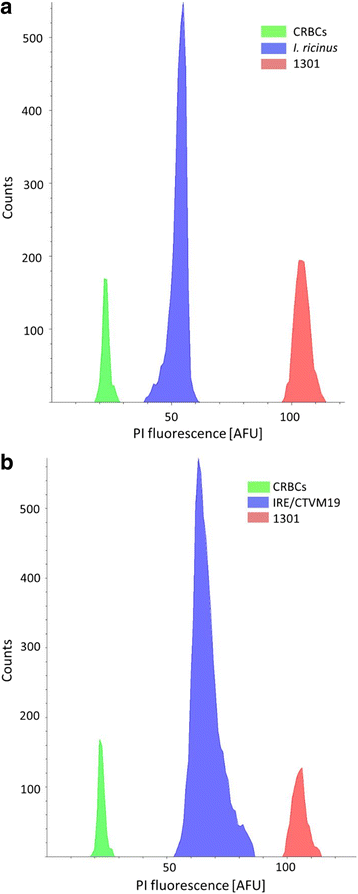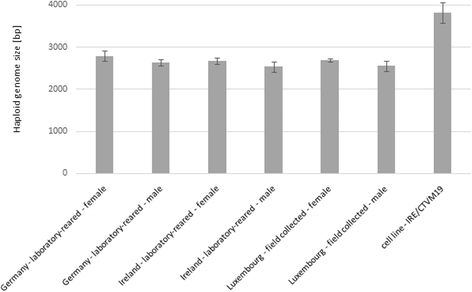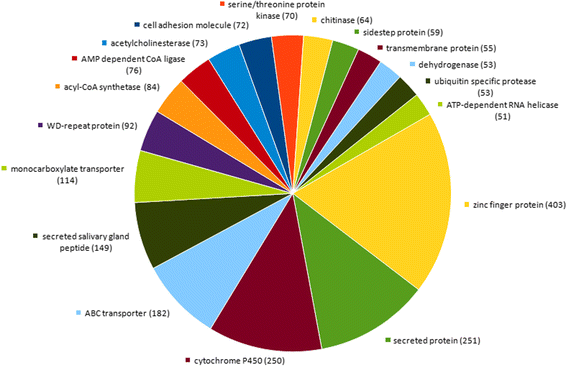Genome scaffolding and annotation for the pathogen vector Ixodes ricinus by ultra-long single molecule sequencing
- PMID: 28179027
- PMCID: PMC5299676
- DOI: 10.1186/s13071-017-2008-9
Genome scaffolding and annotation for the pathogen vector Ixodes ricinus by ultra-long single molecule sequencing
Abstract
Background: Global warming and other ecological changes have facilitated the expansion of Ixodes ricinus tick populations. Ixodes ricinus is the most important carrier of vector-borne pathogens in Europe, transmitting viruses, protozoa and bacteria, in particular Borrelia burgdorferi (sensu lato), the causative agent of Lyme borreliosis, the most prevalent vector-borne disease in humans in the Northern hemisphere. To faster control this disease vector, a better understanding of the I. ricinus tick is necessary. To facilitate such studies, we recently published the first reference genome of this highly prevalent pathogen vector. Here, we further extend these studies by scaffolding and annotating the first reference genome by using ultra-long sequencing reads from third generation single molecule sequencing. In addition, we present the first genome size estimation for I. ricinus ticks and the embryo-derived cell line IRE/CTVM19.
Results: 235,953 contigs were integrated into 204,904 scaffolds, extending the currently known genome lengths by more than 30% from 393 to 516 Mb and the N50 contig value by 87% from 1643 bp to a N50 scaffold value of 3067 bp. In addition, 25,263 sequences were annotated by comparison to the tick's North American relative Ixodes scapularis. After (conserved) hypothetical proteins, zinc finger proteins, secreted proteins and P450 coding proteins were the most prevalent protein categories annotated. Interestingly, more than 50% of the amino acid sequences matching the homology threshold had 95-100% identity to the corresponding I. scapularis gene models. The sequence information was complemented by the first genome size estimation for this species. Flow cytometry-based genome size analysis revealed a haploid genome size of 2.65Gb for I. ricinus ticks and 3.80 Gb for the cell line.
Conclusions: We present a first draft sequence map of the I. ricinus genome based on a PacBio-Illumina assembly. The I. ricinus genome was shown to be 26% (500 Mb) larger than the genome of its American relative I. scapularis. Based on the genome size of 2.65 Gb we estimated that we covered about 67% of the non-repetitive sequences. Genome annotation will facilitate screening for specific molecular pathways in I. ricinus cells and provides an overview of characteristics and functions.
Keywords: Annotation; Flow cytometry; Genome; Haploid genome size estimation; Ixodes ricinus; Single molecule real time sequencing; Tick; Tick cell line.
Figures



Similar articles
-
Europe-Wide Meta-Analysis of Borrelia burgdorferi Sensu Lato Prevalence in Questing Ixodes ricinus Ticks.Appl Environ Microbiol. 2017 Jul 17;83(15):e00609-17. doi: 10.1128/AEM.00609-17. Print 2017 Aug 1. Appl Environ Microbiol. 2017. PMID: 28550059 Free PMC article.
-
An Ixodes ricinus Tick Salivary Lectin Pathway Inhibitor Protects Borrelia burgdorferi sensu lato from Human Complement.Vector Borne Zoonotic Dis. 2016 Apr;16(4):223-8. doi: 10.1089/vbz.2015.1901. Epub 2016 Feb 22. Vector Borne Zoonotic Dis. 2016. PMID: 26901751
-
Host races in Ixodes ricinus, the European vector of Lyme borreliosis.Infect Genet Evol. 2011 Dec;11(8):2043-8. doi: 10.1016/j.meegid.2011.09.016. Epub 2011 Sep 29. Infect Genet Evol. 2011. PMID: 21983685
-
Ecology of Borrelia burgdorferi sensu lato in Europe: transmission dynamics in multi-host systems, influence of molecular processes and effects of climate change.FEMS Microbiol Rev. 2012 Jul;36(4):837-61. doi: 10.1111/j.1574-6976.2011.00312.x. Epub 2011 Dec 28. FEMS Microbiol Rev. 2012. PMID: 22091928 Review.
-
Lyme disease.Rev Sci Tech. 2000 Apr;19(1):121-35. doi: 10.20506/rst.19.1.1205. Rev Sci Tech. 2000. PMID: 11189709 Review.
Cited by
-
A high-quality Ixodes scapularis genome advances tick science.Nat Genet. 2023 Feb;55(2):301-311. doi: 10.1038/s41588-022-01275-w. Epub 2023 Jan 19. Nat Genet. 2023. PMID: 36658436
-
Apoptosis and Autophagy: Current Understanding in Tick-Pathogen Interactions.Front Cell Infect Microbiol. 2022 Jan 27;12:784430. doi: 10.3389/fcimb.2022.784430. eCollection 2022. Front Cell Infect Microbiol. 2022. PMID: 35155277 Free PMC article. Review.
-
Genetic Manipulation of Ticks: A Paradigm Shift in Tick and Tick-Borne Diseases Research.Front Cell Infect Microbiol. 2021 May 10;11:678037. doi: 10.3389/fcimb.2021.678037. eCollection 2021. Front Cell Infect Microbiol. 2021. PMID: 34041045 Free PMC article. Review.
-
Exploration of binary protein-protein interactions between tick-borne flaviviruses and Ixodes ricinus.Parasit Vectors. 2021 Mar 6;14(1):144. doi: 10.1186/s13071-021-04651-3. Parasit Vectors. 2021. PMID: 33676573 Free PMC article.
-
Quantitative Visions of Reality at the Tick-Host Interface: Biochemistry, Genomics, Proteomics, and Transcriptomics as Measures of Complete Inventories of the Tick Sialoverse.Front Cell Infect Microbiol. 2020 Sep 11;10:574405. doi: 10.3389/fcimb.2020.574405. eCollection 2020. Front Cell Infect Microbiol. 2020. PMID: 33042874 Free PMC article. Review.
References
-
- Stark K, Niedrig M, Biederbick W, Merkert H, Hacker J. Climate changes and emerging diseases. What new infectious diseases and health problem can be expected?. Bundesgesundheitsbl. Gesundheitsforsch. Gesundheitsschutz. 2009;52(7):699-714. - PubMed
Publication types
MeSH terms
Grants and funding
LinkOut - more resources
Full Text Sources
Other Literature Sources
Medical
Miscellaneous

